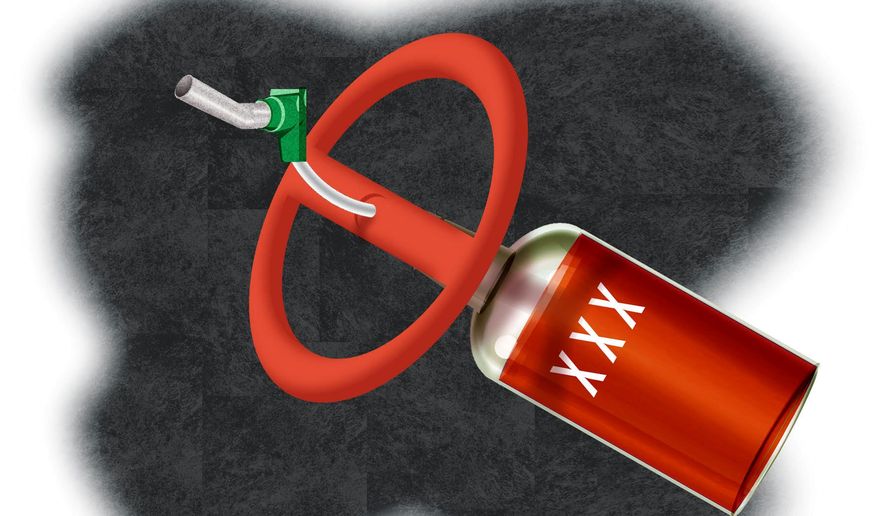OPINION:
Tucked in the $1 trillion infrastructure package moving through Congress is a provision that could leave you stranded far more often than a dead battery. The legislation directs the U.S. Department of Transportation to mandate automakers install alcohol detection devices in all new vehicles.
How will it work? A series of sensors will measure the driver’s breath and blood alcohol concentration (BAC) level. If the BAC reading is too high, the engine would be disabled—stopping a would-be drunk driver from hurting themselves or others. The research and development program to explore the technology has already spent $50 million on the taxpayer’s dime.
It’s a great idea in theory. But in practice, the technology reminds one of the 1970’s seat belt fiasco when cars were disabled if you didn’t buckle up.
Road vibrations, potholes, and exposure to the elements typically create a harsh environment for any vehicle component. But we aren’t speaking about the general reliability of your car clock, radio, or seat belt buzzer. Imagine a sensitive alcohol detection device, which is analyzing the percentage of alcohol molecules in the air or in your blood to three decimal places.
The number of car starts every day is well over a billion. Even an alcohol detection device operating at the government-targeted Six Sigma standard—or 99.99966 percent accuracy—will trigger more than three thousand false readings daily. Getting in your car to go to work or an appointment and expecting it to start will be a daily lottery. And many who have had too much to drink will be able to drive as false readings will be in both directions.
Breathalyzers currently used by law enforcement must be calibrated on a regular basis. A 2019 investigation by The New York Times found that breathalyzers “generate skewed results with alarming frequency.” The authors pointed out that if not maintained correctly, the machines can yield readings that are at times 40 percent too high. Earlier this year, some Massachusetts prosecutors stopped using evidence from breathalyzer tests in drunk driving cases because of their unreliability. How well will these devices work when the sensors are compromised by dusty air from wildfires to construction sites?
Mandating the addition of delicate measurement instruments in all new vehicles will create bigger problems—even for stone-cold tea drinkers. Drivers will be left in vulnerable, if not outright dangerous, situations. How often will they have to be recalibrated to guard against unexpected failure? How will you know when buying a used car out of warranty that the system is properly functioning? Who do you think will pay for recalibration when your system shuts down without cause? The mechanics at your car dealer and the car towing industry will be the biggest beneficiaries of this idea.
What happens when people begin relying on these devices to test if they’re safe to drive? Seriously impaired drivers could be wrongly assured it’s acceptable to hit the road. Who will be liable after that driver crashes? Product liability attorneys will have a new income stream.
The mandate would also create a slippery slope. Once the detection devices are mandated, the same anti-alcohol lobby that demanded the technology be installed will press for lower trigger levels. These lobbyists have been advocating in several states to lower the current “drunk driving” arrest level by 40 percent. If adopted, millions would be arrested at the lower level after one glass of wine. University research indicates driving while on a hands-free cell call is the equivalent impairment of being at the current drunk driving limit. How long after lowering the threshold will they be asking for alcohol detection devices to be set at their new sought-after level?
This attempt to legislate around human behavior reveals the foolish momentum of ideas whose time has come and gone. The original concept seemed attractive a decade ago. But the number of alcohol-related traffic fatalities has declined by half since the 1980s. These dramatic improvements in traffic safety suggest that policymakers should rethink this soon to be failed technology in favor of solutions that are obviously working.
While everyone has played a part in making our roads safer, ubiquitous smartphones and drugged driving associated with legal marijuana are crowding out the alcohol issue while making traffic safety issues more complex. Unfortunately, the road to greater safety won’t be traveled by installing expensive and dangerously unreliable gimmicks to satisfy anti-alcohol lobbyists.
• Richard Berman is president of Berman and Co. in Washington, D.C.




Please read our comment policy before commenting.